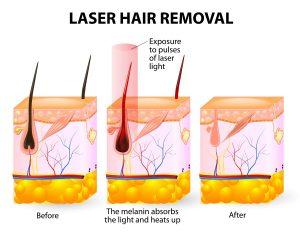Experience the powerful effectiveness of Laser Hair Removal.
Laser hair removal is a popular cosmetic procedure that aims to permanently reduce or eliminate unwanted hair growth. It utilizes concentrated beams of light to target and destroy hair follicles preventing regrowth. Over the years laser hair removal has gained significant attention and undergone advancements in technology making it a widely recognized and effective method for hair removal. In this essay we will explore the working mechanism of laser hair removal, its benefits and limitations, the factors affecting its efficacy and the safety considerations associated with the procedure.
Book your free consultation today
How does Laser Hair Removal work?
The primary principle behind laser hair removal is selective photothermolysis. This process involves targeting the melanin pigment in the hair follicles while minimizing damage to the surrounding skin. Melanin absorbs the laser energy which is then converted into heat, damaging the hair follicles and inhibiting further growth. Different laser systems such as alexandrite, diode and Nd:YAG are used based on the patient’s skin type, hair colour and the location being treated.

One of the major advantages of laser hair removal is its long-term effectiveness. Unlike temporary methods like shaving or waxing laser treatment can provide long-lasting results. Multiple treatment sessions are typically required to target hair follicles in different growth phases. Since hair growth occurs in cycles only follicles in the active growth phase can be effectively treated. Thus, several sessions spaced over several weeks or months are necessary to ensure that all targeted follicles are treated during their active growth stage.
Furthermore, laser hair removal offers precision and efficiency. The treatment can selectively target dark coarse hairs while leaving the surrounding skin undamaged. The laser’s wide beam allows for the rapid treatment of multiple hair follicles simultaneously making it suitable for large areas like the back or legs. Moreover, the procedure is relatively quick with each laser pulse treating an area approximately between 2cm and 8cm. Small areas such as the upper lip can be treated in a matter of minutes while larger areas may take up to an hour.
Laser hair removal is also known for its versatility as it can be applied to various body areas including the face, legs, arms, underarms, bikini line and even sensitive areas like the nipples or the pubic region. It is important to note however that laser hair removal may not be suitable for all skin and hair types. The procedure is generally most effective on individuals with light skin and dark hair as the laser targets the melanin pigment. People with lighter hair colours such as blonde, red, or grey may experience limited results due to the lack of melanin to absorb the laser energy.
While laser hair removal offers numerous benefits it is essential to acknowledge its limitations. Complete and permanent hair removal is not always achievable for everyone as individual responses to treatment can vary. Some individuals may experience significant hair reduction while others may only achieve hair thinning. Factors such as hormonal imbalances, underlying medical conditions and genetic predisposition can influence the outcome. Additionally, new hair follicles can develop due to factors like aging or hormonal changes requiring maintenance sessions to sustain the desired results.
Effectiveness of Laser Hair Removal for various skin types
The effectiveness of laser hair removal is also influenced by various factors including the patient’s skin type, hair colour and the expertise of the practitioner. The ideal candidate for laser hair removal has light skin and dark hair as the contrast facilitates the absorption of laser energy by the hair follicles. However, advancements in laser technology have made it possible to treat individuals with darker skin tones by using specific lasers and adjusting the settings to minimize the risk of complications.
The practitioner’s experience and skill in performing the procedure are crucial for achieving optimal results and ensuring patient safety. Adequate training and knowledge of the laser equipment are necessary to determine the appropriate laser type, settings and treatment plan for each patient.
Furthermore, safety considerations play a significant role in laser hair removal. While the procedure is generally safe when performed by qualified professionals there are potential risks and side effects that need to be addressed. Common side effects include temporary skin redness, mild swelling and a sensation resembling a sunburn. These effects typically subside within a few hours to a couple of days after treatment.
In rare cases, more severe side effects may occur such as blistering, scarring or changes in skin pigmentation. The risk of adverse effects can be minimized by adhering to proper treatment guidelines, using appropriate laser parameters and conducting a thorough assessment of the patient’s medical history and skin type before proceeding with the procedure.
It is crucial to note that laser hair removal should be performed in a controlled and regulated environment. In many countries, regulations and standards have been established to ensure the safety and efficacy of the procedure. Qualified practitioners should follow these guidelines and maintain high standards of hygiene and patient care. Patients considering laser hair removal should seek reputable clinics or licensed professionals who have received proper training and certification.
When preparing for laser hair removal it is important to avoid sun exposure and tanning before the treatment. Sunburned or tanned skin can increase the risk of adverse reactions such as burns or changes in pigmentation. Additionally, certain medications and skincare products such as retinoids or photosensitizing drugs may need to be temporarily discontinued before the procedure to reduce the risk of complications.
While laser hair removal is generally safe and effective it is not suitable for everyone. Pregnant women, individuals with certain skin conditions or infections and those with a history of keloid scarring may be advised against undergoing the treatment. A thorough consultation with a qualified professional is necessary to assess the patient’s eligibility and determine the most appropriate course of action.
Laser hair removal is a widely recognized and effective method for reducing unwanted hair growth. Its principle of selective photothermolysis allows for targeted destruction of hair follicles resulting in long-lasting hair reduction. The procedure offers precision, efficiency and versatility, making it suitable for various body areas. However, its effectiveness can vary depending on factors such as skin type, hair colour and individual response to treatment. Safety considerations and proper practitioner expertise are essential for minimizing risks and achieving optimal results. By understanding the benefits, limitations and safety considerations associated with laser hair removal individuals can make informed decisions regarding their hair removal needs.
In recent years, advancements in laser technology have further improved the efficacy and safety of laser hair removal. Newer laser systems and devices have been developed offering better targeting of hair follicles, faster treatment times and reduced discomfort during the procedure. For example, some lasers now utilize cooling mechanisms such as a built-in cooling tip or a cold air system to minimize the sensation of heat and increase patient comfort.
Additionally, researchers continue to explore innovative approaches to enhance the effectiveness of laser hair removal. It is worth noting that laser hair removal is not a one-size-fits-all solution. The number of treatment sessions required can vary depending on factors such as the targeted area, hair density and individual response to treatment. On average, most patients require multiple sessions usually spaced 4 to 6 weeks apart to achieve the desired results. Maintenance sessions may also be needed in the future to address any new hair growth that may occur over time.
Cost is another factor to consider when contemplating laser hair removal. The total cost depends on various factors including the size of the treatment area, the number of sessions required and the geographical location of the clinic. While the upfront cost of laser hair removal may be higher compared to temporary hair removal methods the long-term benefits and reduced need for ongoing maintenance can make it a cost-effective option in the long run.
It is important to manage expectations when undergoing laser hair removal. While the procedure can significantly reduce hair growth complete hair removal may not always be achieved. Some fine or light-coloured hairs may be resistant to laser treatment or may require additional sessions to achieve desired results. Realistic expectations, open communication with the practitioner and understanding the limitations of the procedure are essential for a satisfactory outcome.
Patient satisfaction with laser hair removal is generally high with many individuals reporting a significant reduction in hair growth and increased confidence in their appearance. The convenience of long-lasting results and the elimination of the daily hassle of shaving or waxing make laser hair removal an attractive option for many.
However, it is important to note that individual experiences with laser hair removal can vary. Factors such as hair colour, skin type, hormonal changes and underlying medical conditions can influence the effectiveness of the treatment. It is advisable to consult with a qualified practitioner who can assess your unique circumstances and provide personalized recommendations.
In recent years, there have been further advancements in laser hair removal technology aimed at improving its effectiveness and safety. These advancements include the development of more sophisticated laser systems and innovative techniques.
One notable advancement is the introduction of diode lasers with longer wavelengths. These lasers have proven to be effective in targeting a wider range of skin and hair types including individuals with darker skin tones or lighter hair colours. The longer wavelength allows for better penetration into the hair follicles while minimizing damage to the surrounding skin.
Another technological innovation is the use of cooling mechanisms integrated into the laser devices. These cooling systems help to protect the skin’s surface and make the treatment more comfortable for patients. Cooling techniques may involve contact cooling where a cooling gel or chilled tip is applied to the skin which releases a burst of cool air during the laser pulse.
Additionally, advancements in laser pulse durations have provided more flexibility in targeting different hair types. For example, longer pulse durations are effective for coarse or dark hair while shorter pulse durations are suitable for finer or lighter hair. This customization of pulse durations allows for precise treatment tailored to individual hair characteristics.
The introduction of advanced techniques such as fractional laser technology has also expanded the application of laser hair removal. Fractional lasers deliver the laser energy in a pattern of microscopic columns targeting only a fraction of the skin while leaving the surrounding tissue intact. This technique allows for faster healing and reduces the risk of side effects such as skin redness or irritation.
Moreover, the continuous development of laser hair removal protocols and treatment guidelines has contributed to improving the overall outcomes of the procedure. These protocols include recommendations for pre-treatment preparation, post-treatment care and optimal treatment intervals. Following these guidelines ensures consistent and effective results while minimizing the risk of adverse effects.
It is worth noting that laser hair removal technology continues to evolve and ongoing research and development are focused on enhancing its efficacy and safety. This includes exploring new laser types, improving energy delivery systems and refining treatment protocols. These advancements aim to further optimize the procedure’s outcomes, expand its applicability to a wider range of patients and minimize the potential risks involved.
Laser hair removal has witnessed significant advancements in technology leading to improved effectiveness and safety. These advancements include the development of laser systems suitable for various skin and hair types, the integration of cooling mechanisms to enhance patient comfort and the introduction of innovative techniques and treatment protocols. These ongoing advancements continue to contribute to the popularity and success of laser hair removal as a long-term hair reduction solution. However, it is important to seek treatment from qualified professionals and adhere to their guidance to ensure optimal results and minimize potential risks.
In conclusion, laser hair removal is a widely recognized and effective method for reducing or eliminating unwanted hair growth. It offers long-term results, precision and efficiency compared to temporary hair removal methods. However, its effectiveness can vary depending on individual factors and multiple sessions may be required for optimal results. Safety considerations, proper practitioner expertise and adherence to treatment guidelines are crucial for minimizing risks and achieving satisfactory outcomes. With advancements in technology and ongoing research laser hair removal continues to evolve offering enhanced efficacy and improved patient comfort.
You can check out our Price list or if you prefer a more accurate quote why not use our https://www.withoutatracetamworth.co.uk/laser-hair-removal/#quote or alternatively book a Free Consultation below.
For more information on prices and special offers, to view our gallery or browse our Q&A section please click on the following link
https://www.withoutatracetamworth.co.uk/laser-hair-removal
Laser Hair Removal Skin Types 1 - 6
The Fitzpatrick skin type process is a way of classifying skin types based on how they react to exposure to ultraviolet (UV) light. It was developed in 1975 by American dermatologist Thomas B. Fitzpatrick.
The Fitzpatrick scale has six categories, from Type 1 to Type 6:



















